Business and the Business Environment Report: Cadbury Company Analysis
VerifiedAdded on 2020/11/12
|10
|2472
|232
Report
AI Summary
This report provides a comprehensive analysis of the business environment, focusing on different types of organizations (public, private, voluntary, and SMEs), their purposes, and legal structures. It uses Cadbury as a case study, examining its organizational structure, the relationship between various organizational functions (marketing, finance, HR, and operations), and how these functions interrelate to achieve organizational objectives. The report also explores the positive and negative impacts on business operations, incorporating PESTLE and SWOT analyses to identify internal strengths and weaknesses and how they relate to external macro factors. The report concludes by summarizing the key findings and emphasizing the importance of understanding the business environment for effective business operations and strategic decision-making. It also includes references to relevant academic sources.
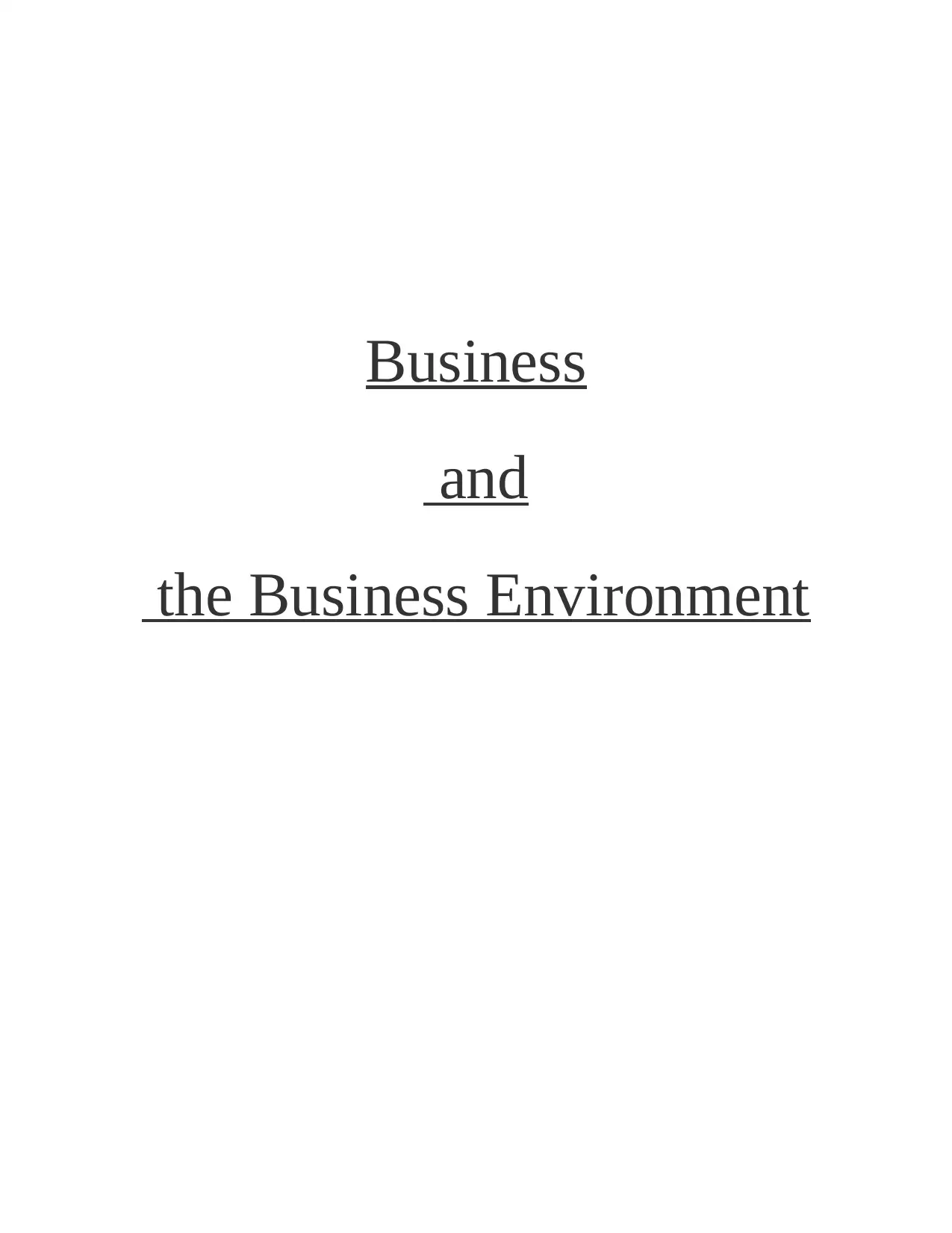
Business
and
the Business Environment
and
the Business Environment
Paraphrase This Document
Need a fresh take? Get an instant paraphrase of this document with our AI Paraphraser
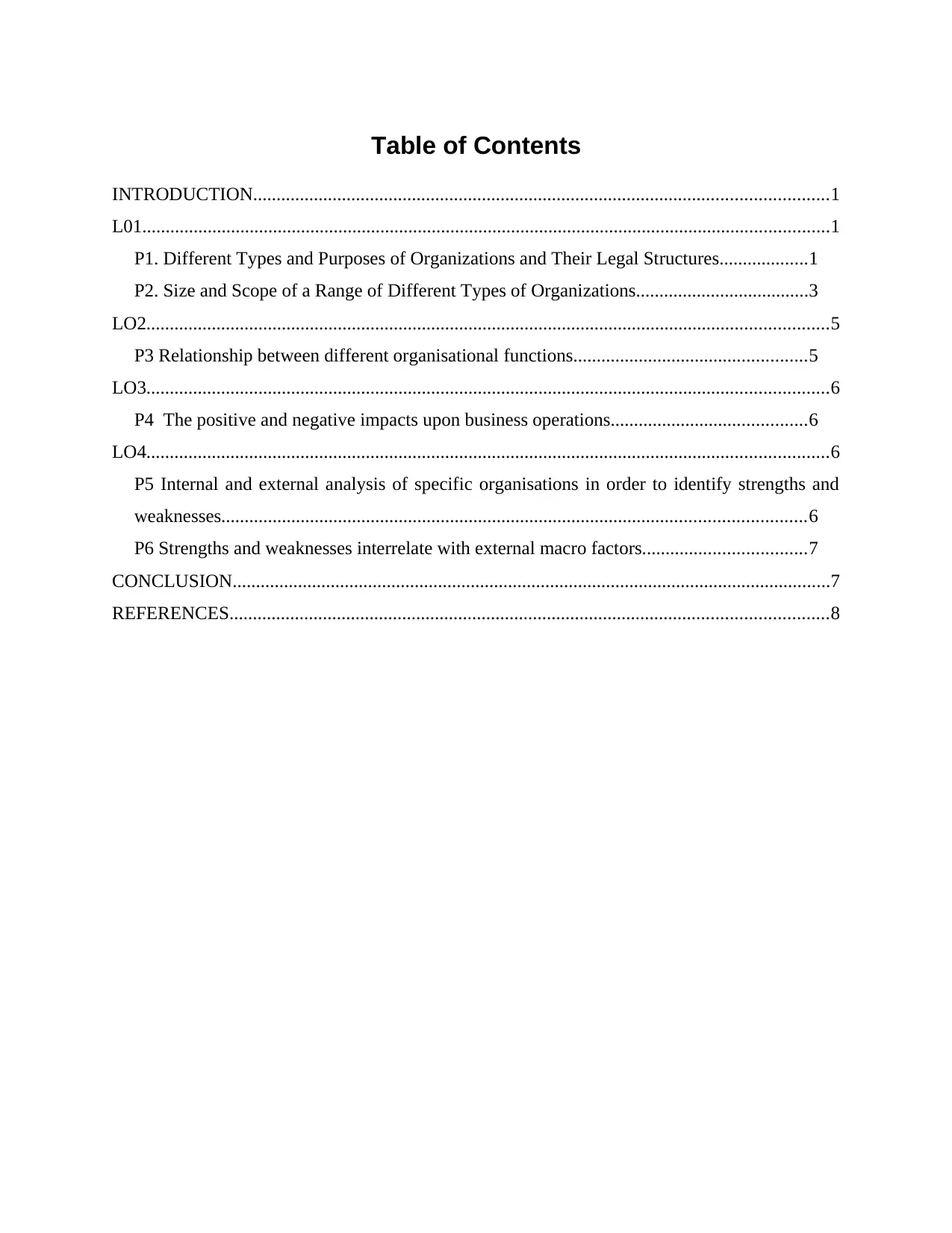
Table of Contents
INTRODUCTION...........................................................................................................................1
L01...................................................................................................................................................1
P1. Different Types and Purposes of Organizations and Their Legal Structures...................1
P2. Size and Scope of a Range of Different Types of Organizations.....................................3
LO2..................................................................................................................................................5
P3 Relationship between different organisational functions..................................................5
LO3..................................................................................................................................................6
P4 The positive and negative impacts upon business operations..........................................6
LO4..................................................................................................................................................6
P5 Internal and external analysis of specific organisations in order to identify strengths and
weaknesses.............................................................................................................................6
P6 Strengths and weaknesses interrelate with external macro factors...................................7
CONCLUSION................................................................................................................................7
REFERENCES................................................................................................................................8
INTRODUCTION...........................................................................................................................1
L01...................................................................................................................................................1
P1. Different Types and Purposes of Organizations and Their Legal Structures...................1
P2. Size and Scope of a Range of Different Types of Organizations.....................................3
LO2..................................................................................................................................................5
P3 Relationship between different organisational functions..................................................5
LO3..................................................................................................................................................6
P4 The positive and negative impacts upon business operations..........................................6
LO4..................................................................................................................................................6
P5 Internal and external analysis of specific organisations in order to identify strengths and
weaknesses.............................................................................................................................6
P6 Strengths and weaknesses interrelate with external macro factors...................................7
CONCLUSION................................................................................................................................7
REFERENCES................................................................................................................................8
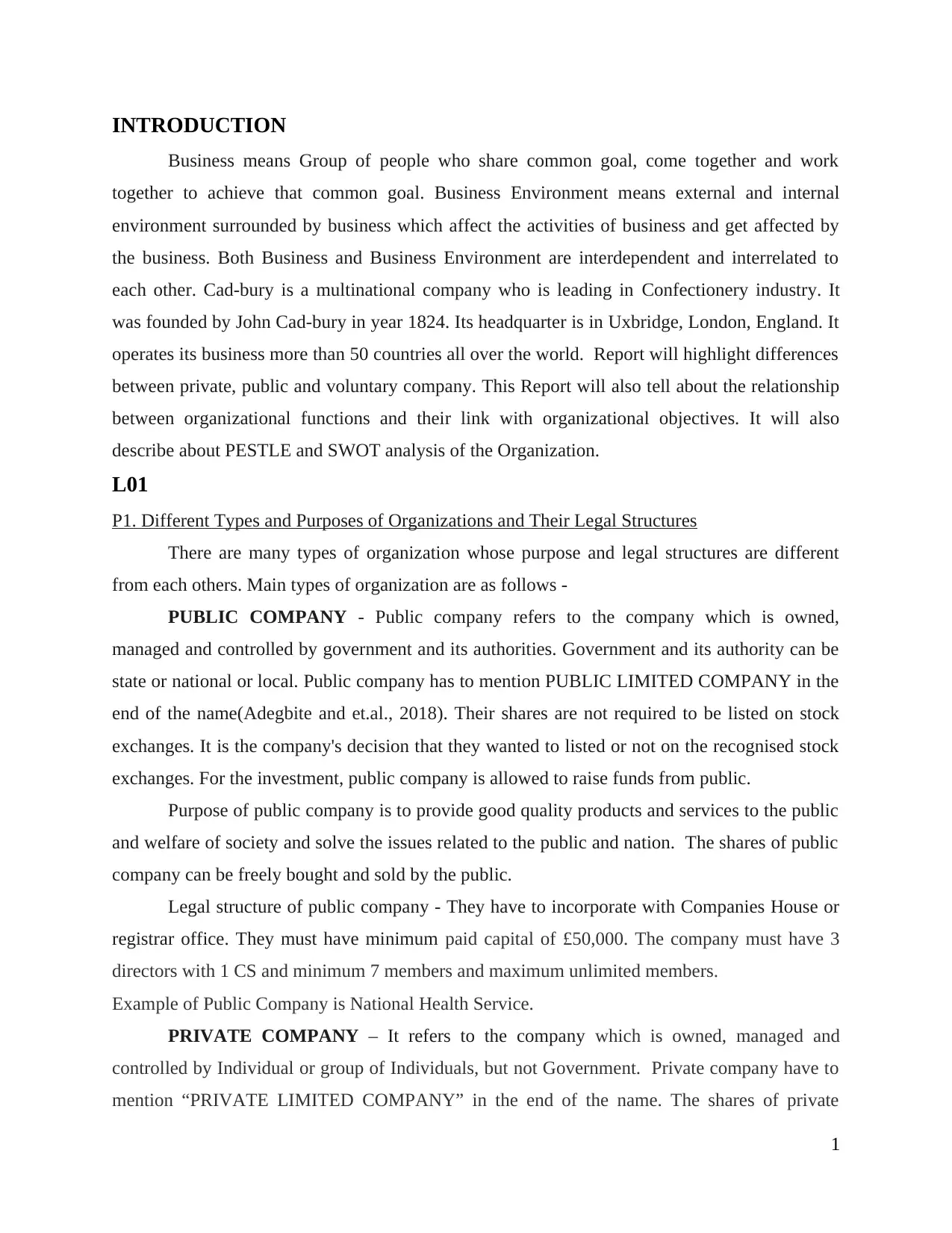
INTRODUCTION
Business means Group of people who share common goal, come together and work
together to achieve that common goal. Business Environment means external and internal
environment surrounded by business which affect the activities of business and get affected by
the business. Both Business and Business Environment are interdependent and interrelated to
each other. Cad-bury is a multinational company who is leading in Confectionery industry. It
was founded by John Cad-bury in year 1824. Its headquarter is in Uxbridge, London, England. It
operates its business more than 50 countries all over the world. Report will highlight differences
between private, public and voluntary company. This Report will also tell about the relationship
between organizational functions and their link with organizational objectives. It will also
describe about PESTLE and SWOT analysis of the Organization.
L01
P1. Different Types and Purposes of Organizations and Their Legal Structures
There are many types of organization whose purpose and legal structures are different
from each others. Main types of organization are as follows -
PUBLIC COMPANY - Public company refers to the company which is owned,
managed and controlled by government and its authorities. Government and its authority can be
state or national or local. Public company has to mention PUBLIC LIMITED COMPANY in the
end of the name(Adegbite and et.al., 2018). Their shares are not required to be listed on stock
exchanges. It is the company's decision that they wanted to listed or not on the recognised stock
exchanges. For the investment, public company is allowed to raise funds from public.
Purpose of public company is to provide good quality products and services to the public
and welfare of society and solve the issues related to the public and nation. The shares of public
company can be freely bought and sold by the public.
Legal structure of public company - They have to incorporate with Companies House or
registrar office. They must have minimum paid capital of £50,000. The company must have 3
directors with 1 CS and minimum 7 members and maximum unlimited members.
Example of Public Company is National Health Service.
PRIVATE COMPANY – It refers to the company which is owned, managed and
controlled by Individual or group of Individuals, but not Government. Private company have to
mention “PRIVATE LIMITED COMPANY” in the end of the name. The shares of private
1
Business means Group of people who share common goal, come together and work
together to achieve that common goal. Business Environment means external and internal
environment surrounded by business which affect the activities of business and get affected by
the business. Both Business and Business Environment are interdependent and interrelated to
each other. Cad-bury is a multinational company who is leading in Confectionery industry. It
was founded by John Cad-bury in year 1824. Its headquarter is in Uxbridge, London, England. It
operates its business more than 50 countries all over the world. Report will highlight differences
between private, public and voluntary company. This Report will also tell about the relationship
between organizational functions and their link with organizational objectives. It will also
describe about PESTLE and SWOT analysis of the Organization.
L01
P1. Different Types and Purposes of Organizations and Their Legal Structures
There are many types of organization whose purpose and legal structures are different
from each others. Main types of organization are as follows -
PUBLIC COMPANY - Public company refers to the company which is owned,
managed and controlled by government and its authorities. Government and its authority can be
state or national or local. Public company has to mention PUBLIC LIMITED COMPANY in the
end of the name(Adegbite and et.al., 2018). Their shares are not required to be listed on stock
exchanges. It is the company's decision that they wanted to listed or not on the recognised stock
exchanges. For the investment, public company is allowed to raise funds from public.
Purpose of public company is to provide good quality products and services to the public
and welfare of society and solve the issues related to the public and nation. The shares of public
company can be freely bought and sold by the public.
Legal structure of public company - They have to incorporate with Companies House or
registrar office. They must have minimum paid capital of £50,000. The company must have 3
directors with 1 CS and minimum 7 members and maximum unlimited members.
Example of Public Company is National Health Service.
PRIVATE COMPANY – It refers to the company which is owned, managed and
controlled by Individual or group of Individuals, but not Government. Private company have to
mention “PRIVATE LIMITED COMPANY” in the end of the name. The shares of private
1
⊘ This is a preview!⊘
Do you want full access?
Subscribe today to unlock all pages.

Trusted by 1+ million students worldwide
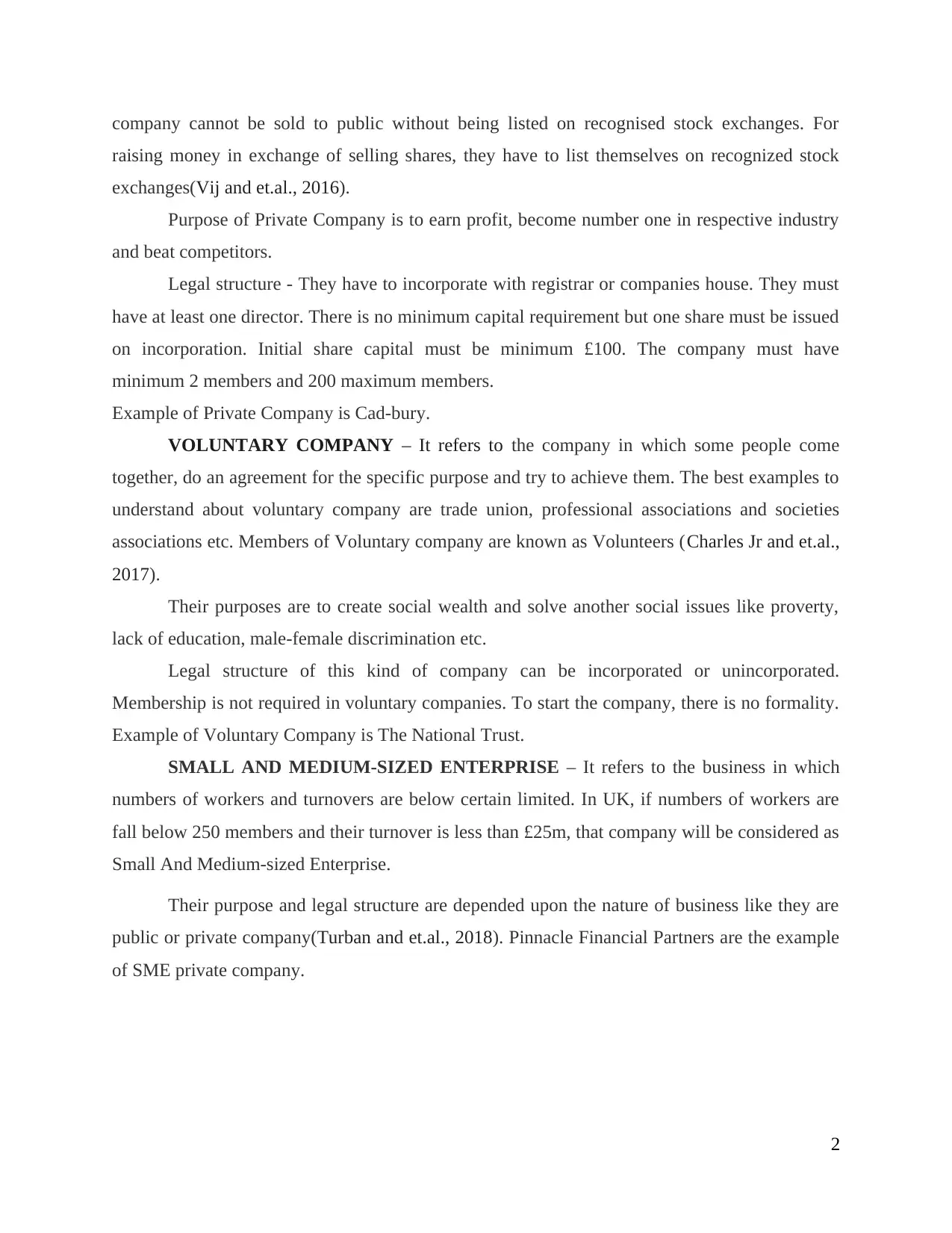
company cannot be sold to public without being listed on recognised stock exchanges. For
raising money in exchange of selling shares, they have to list themselves on recognized stock
exchanges(Vij and et.al., 2016).
Purpose of Private Company is to earn profit, become number one in respective industry
and beat competitors.
Legal structure - They have to incorporate with registrar or companies house. They must
have at least one director. There is no minimum capital requirement but one share must be issued
on incorporation. Initial share capital must be minimum £100. The company must have
minimum 2 members and 200 maximum members.
Example of Private Company is Cad-bury.
VOLUNTARY COMPANY – It refers to the company in which some people come
together, do an agreement for the specific purpose and try to achieve them. The best examples to
understand about voluntary company are trade union, professional associations and societies
associations etc. Members of Voluntary company are known as Volunteers (Charles Jr and et.al.,
2017).
Their purposes are to create social wealth and solve another social issues like proverty,
lack of education, male-female discrimination etc.
Legal structure of this kind of company can be incorporated or unincorporated.
Membership is not required in voluntary companies. To start the company, there is no formality.
Example of Voluntary Company is The National Trust.
SMALL AND MEDIUM-SIZED ENTERPRISE – It refers to the business in which
numbers of workers and turnovers are below certain limited. In UK, if numbers of workers are
fall below 250 members and their turnover is less than £25m, that company will be considered as
Small And Medium-sized Enterprise.
Their purpose and legal structure are depended upon the nature of business like they are
public or private company(Turban and et.al., 2018). Pinnacle Financial Partners are the example
of SME private company.
2
raising money in exchange of selling shares, they have to list themselves on recognized stock
exchanges(Vij and et.al., 2016).
Purpose of Private Company is to earn profit, become number one in respective industry
and beat competitors.
Legal structure - They have to incorporate with registrar or companies house. They must
have at least one director. There is no minimum capital requirement but one share must be issued
on incorporation. Initial share capital must be minimum £100. The company must have
minimum 2 members and 200 maximum members.
Example of Private Company is Cad-bury.
VOLUNTARY COMPANY – It refers to the company in which some people come
together, do an agreement for the specific purpose and try to achieve them. The best examples to
understand about voluntary company are trade union, professional associations and societies
associations etc. Members of Voluntary company are known as Volunteers (Charles Jr and et.al.,
2017).
Their purposes are to create social wealth and solve another social issues like proverty,
lack of education, male-female discrimination etc.
Legal structure of this kind of company can be incorporated or unincorporated.
Membership is not required in voluntary companies. To start the company, there is no formality.
Example of Voluntary Company is The National Trust.
SMALL AND MEDIUM-SIZED ENTERPRISE – It refers to the business in which
numbers of workers and turnovers are below certain limited. In UK, if numbers of workers are
fall below 250 members and their turnover is less than £25m, that company will be considered as
Small And Medium-sized Enterprise.
Their purpose and legal structure are depended upon the nature of business like they are
public or private company(Turban and et.al., 2018). Pinnacle Financial Partners are the example
of SME private company.
2
Paraphrase This Document
Need a fresh take? Get an instant paraphrase of this document with our AI Paraphraser
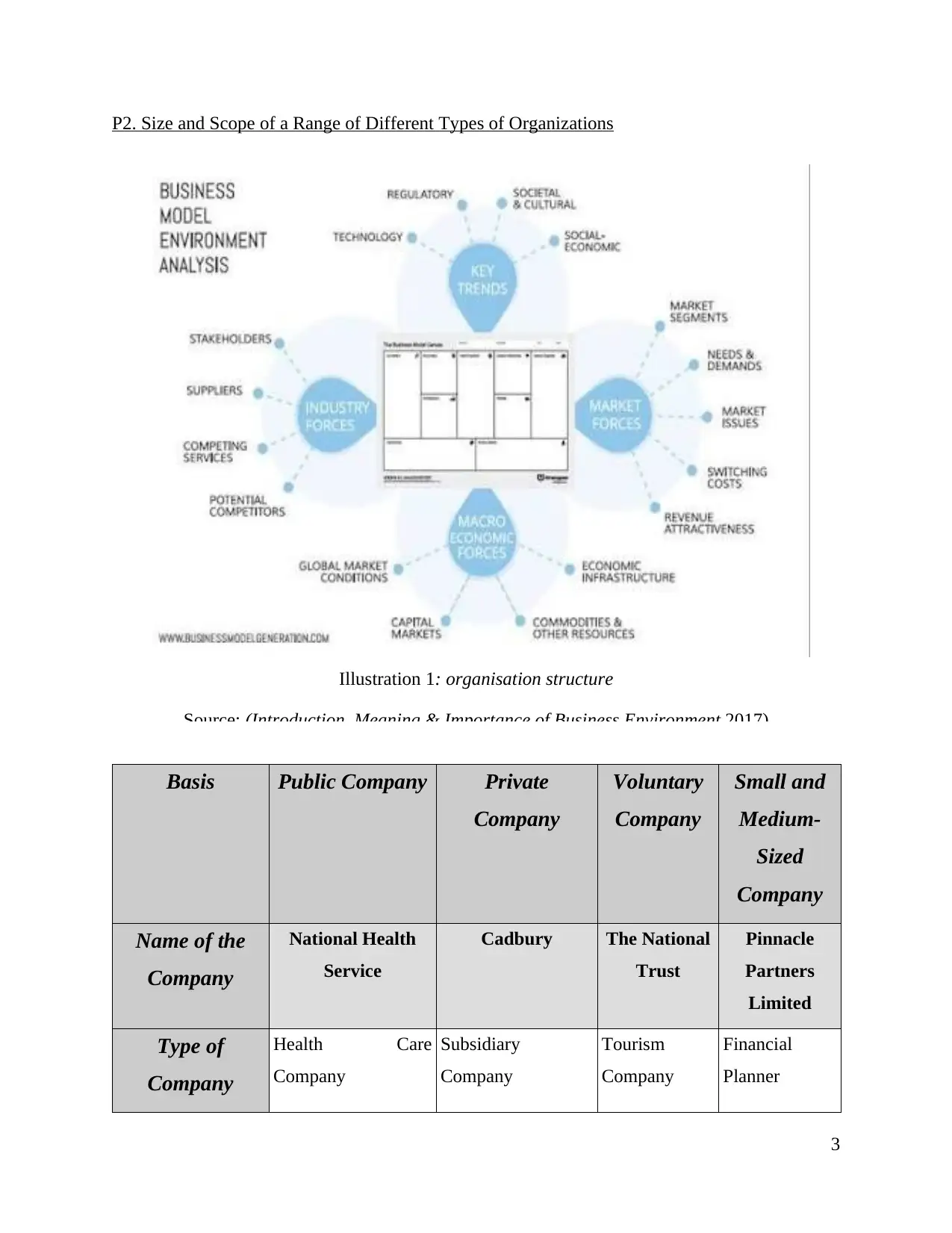
P2. Size and Scope of a Range of Different Types of Organizations
Basis Public Company Private
Company
Voluntary
Company
Small and
Medium-
Sized
Company
Name of the
Company
National Health
Service
Cadbury The National
Trust
Pinnacle
Partners
Limited
Type of
Company
Health Care
Company
Subsidiary
Company
Tourism
Company
Financial
Planner
3
Illustration 1: organisation structure
Source: (Introduction, Meaning & Importance of Business Environment 2017)
Basis Public Company Private
Company
Voluntary
Company
Small and
Medium-
Sized
Company
Name of the
Company
National Health
Service
Cadbury The National
Trust
Pinnacle
Partners
Limited
Type of
Company
Health Care
Company
Subsidiary
Company
Tourism
Company
Financial
Planner
3
Illustration 1: organisation structure
Source: (Introduction, Meaning & Importance of Business Environment 2017)
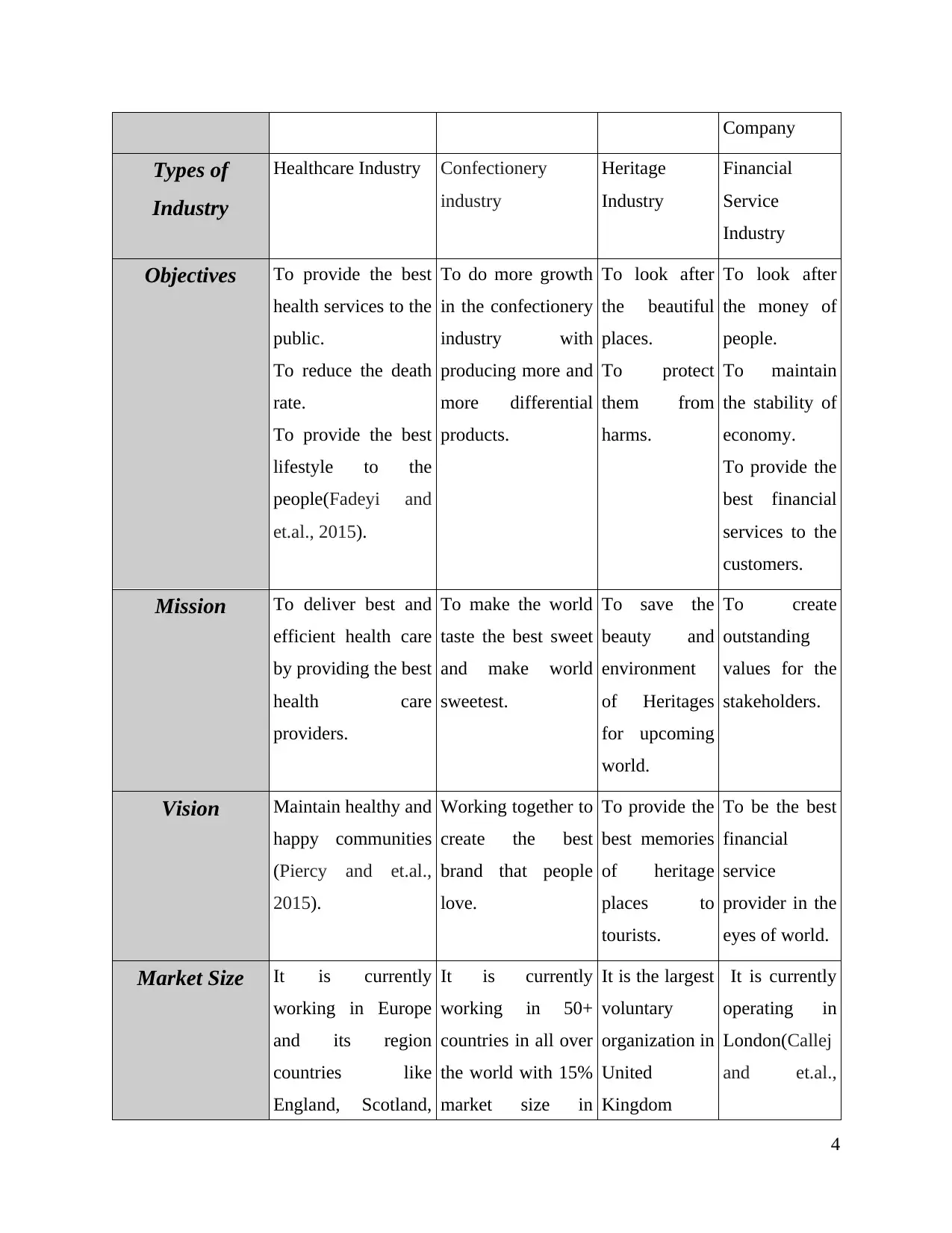
Company
Types of
Industry
Healthcare Industry Confectionery
industry
Heritage
Industry
Financial
Service
Industry
Objectives To provide the best
health services to the
public.
To reduce the death
rate.
To provide the best
lifestyle to the
people(Fadeyi and
et.al., 2015).
To do more growth
in the confectionery
industry with
producing more and
more differential
products.
To look after
the beautiful
places.
To protect
them from
harms.
To look after
the money of
people.
To maintain
the stability of
economy.
To provide the
best financial
services to the
customers.
Mission To deliver best and
efficient health care
by providing the best
health care
providers.
To make the world
taste the best sweet
and make world
sweetest.
To save the
beauty and
environment
of Heritages
for upcoming
world.
To create
outstanding
values for the
stakeholders.
Vision Maintain healthy and
happy communities
(Piercy and et.al.,
2015).
Working together to
create the best
brand that people
love.
To provide the
best memories
of heritage
places to
tourists.
To be the best
financial
service
provider in the
eyes of world.
Market Size It is currently
working in Europe
and its region
countries like
England, Scotland,
It is currently
working in 50+
countries in all over
the world with 15%
market size in
It is the largest
voluntary
organization in
United
Kingdom
It is currently
operating in
London(Callej
and et.al.,
4
Types of
Industry
Healthcare Industry Confectionery
industry
Heritage
Industry
Financial
Service
Industry
Objectives To provide the best
health services to the
public.
To reduce the death
rate.
To provide the best
lifestyle to the
people(Fadeyi and
et.al., 2015).
To do more growth
in the confectionery
industry with
producing more and
more differential
products.
To look after
the beautiful
places.
To protect
them from
harms.
To look after
the money of
people.
To maintain
the stability of
economy.
To provide the
best financial
services to the
customers.
Mission To deliver best and
efficient health care
by providing the best
health care
providers.
To make the world
taste the best sweet
and make world
sweetest.
To save the
beauty and
environment
of Heritages
for upcoming
world.
To create
outstanding
values for the
stakeholders.
Vision Maintain healthy and
happy communities
(Piercy and et.al.,
2015).
Working together to
create the best
brand that people
love.
To provide the
best memories
of heritage
places to
tourists.
To be the best
financial
service
provider in the
eyes of world.
Market Size It is currently
working in Europe
and its region
countries like
England, Scotland,
It is currently
working in 50+
countries in all over
the world with 15%
market size in
It is the largest
voluntary
organization in
United
Kingdom
It is currently
operating in
London(Callej
and et.al.,
4
⊘ This is a preview!⊘
Do you want full access?
Subscribe today to unlock all pages.

Trusted by 1+ million students worldwide
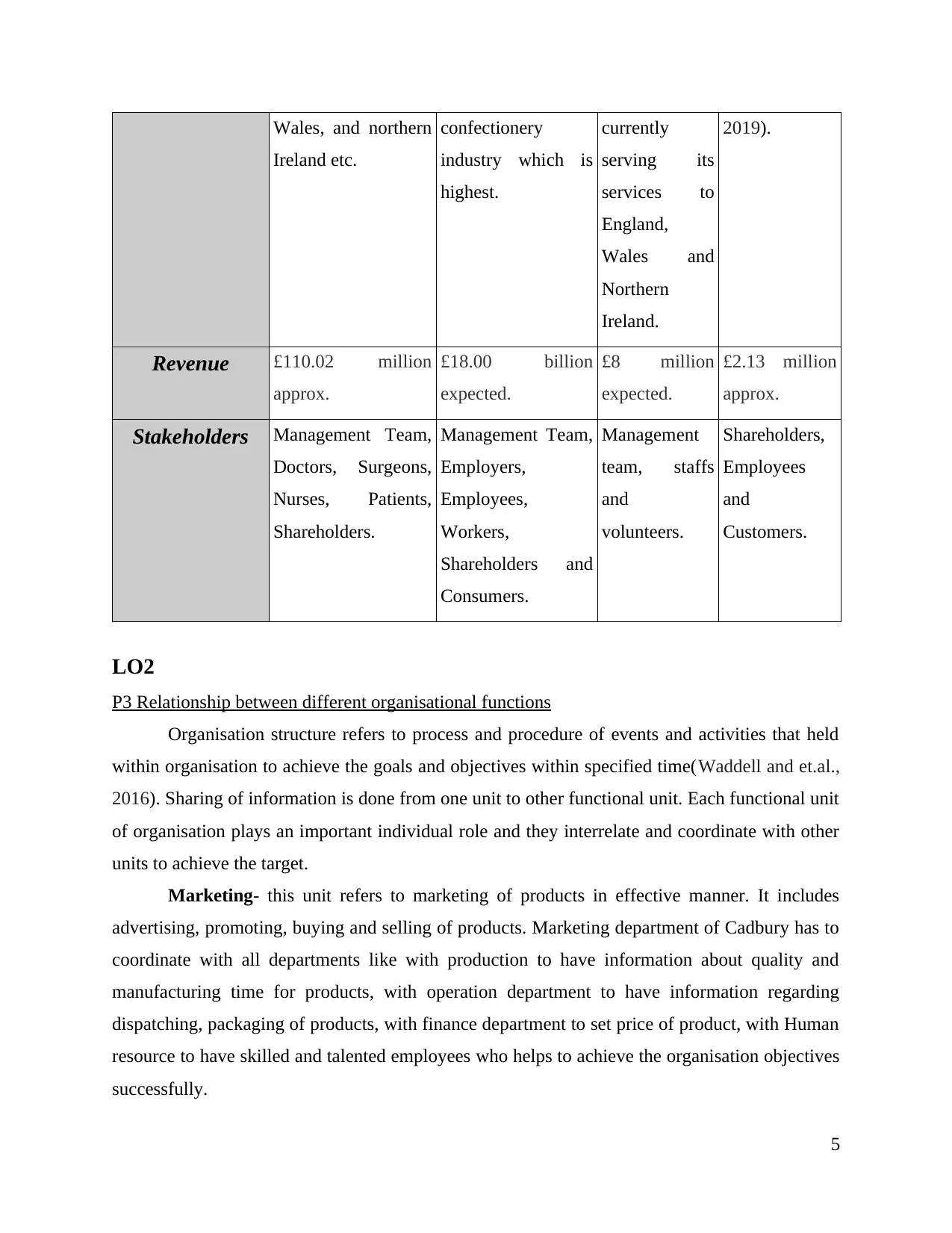
Wales, and northern
Ireland etc.
confectionery
industry which is
highest.
currently
serving its
services to
England,
Wales and
Northern
Ireland.
2019).
Revenue £110.02 million
approx.
£18.00 billion
expected.
£8 million
expected.
£2.13 million
approx.
Stakeholders Management Team,
Doctors, Surgeons,
Nurses, Patients,
Shareholders.
Management Team,
Employers,
Employees,
Workers,
Shareholders and
Consumers.
Management
team, staffs
and
volunteers.
Shareholders,
Employees
and
Customers.
LO2
P3 Relationship between different organisational functions
Organisation structure refers to process and procedure of events and activities that held
within organisation to achieve the goals and objectives within specified time(Waddell and et.al.,
2016). Sharing of information is done from one unit to other functional unit. Each functional unit
of organisation plays an important individual role and they interrelate and coordinate with other
units to achieve the target.
Marketing- this unit refers to marketing of products in effective manner. It includes
advertising, promoting, buying and selling of products. Marketing department of Cadbury has to
coordinate with all departments like with production to have information about quality and
manufacturing time for products, with operation department to have information regarding
dispatching, packaging of products, with finance department to set price of product, with Human
resource to have skilled and talented employees who helps to achieve the organisation objectives
successfully.
5
Ireland etc.
confectionery
industry which is
highest.
currently
serving its
services to
England,
Wales and
Northern
Ireland.
2019).
Revenue £110.02 million
approx.
£18.00 billion
expected.
£8 million
expected.
£2.13 million
approx.
Stakeholders Management Team,
Doctors, Surgeons,
Nurses, Patients,
Shareholders.
Management Team,
Employers,
Employees,
Workers,
Shareholders and
Consumers.
Management
team, staffs
and
volunteers.
Shareholders,
Employees
and
Customers.
LO2
P3 Relationship between different organisational functions
Organisation structure refers to process and procedure of events and activities that held
within organisation to achieve the goals and objectives within specified time(Waddell and et.al.,
2016). Sharing of information is done from one unit to other functional unit. Each functional unit
of organisation plays an important individual role and they interrelate and coordinate with other
units to achieve the target.
Marketing- this unit refers to marketing of products in effective manner. It includes
advertising, promoting, buying and selling of products. Marketing department of Cadbury has to
coordinate with all departments like with production to have information about quality and
manufacturing time for products, with operation department to have information regarding
dispatching, packaging of products, with finance department to set price of product, with Human
resource to have skilled and talented employees who helps to achieve the organisation objectives
successfully.
5
Paraphrase This Document
Need a fresh take? Get an instant paraphrase of this document with our AI Paraphraser
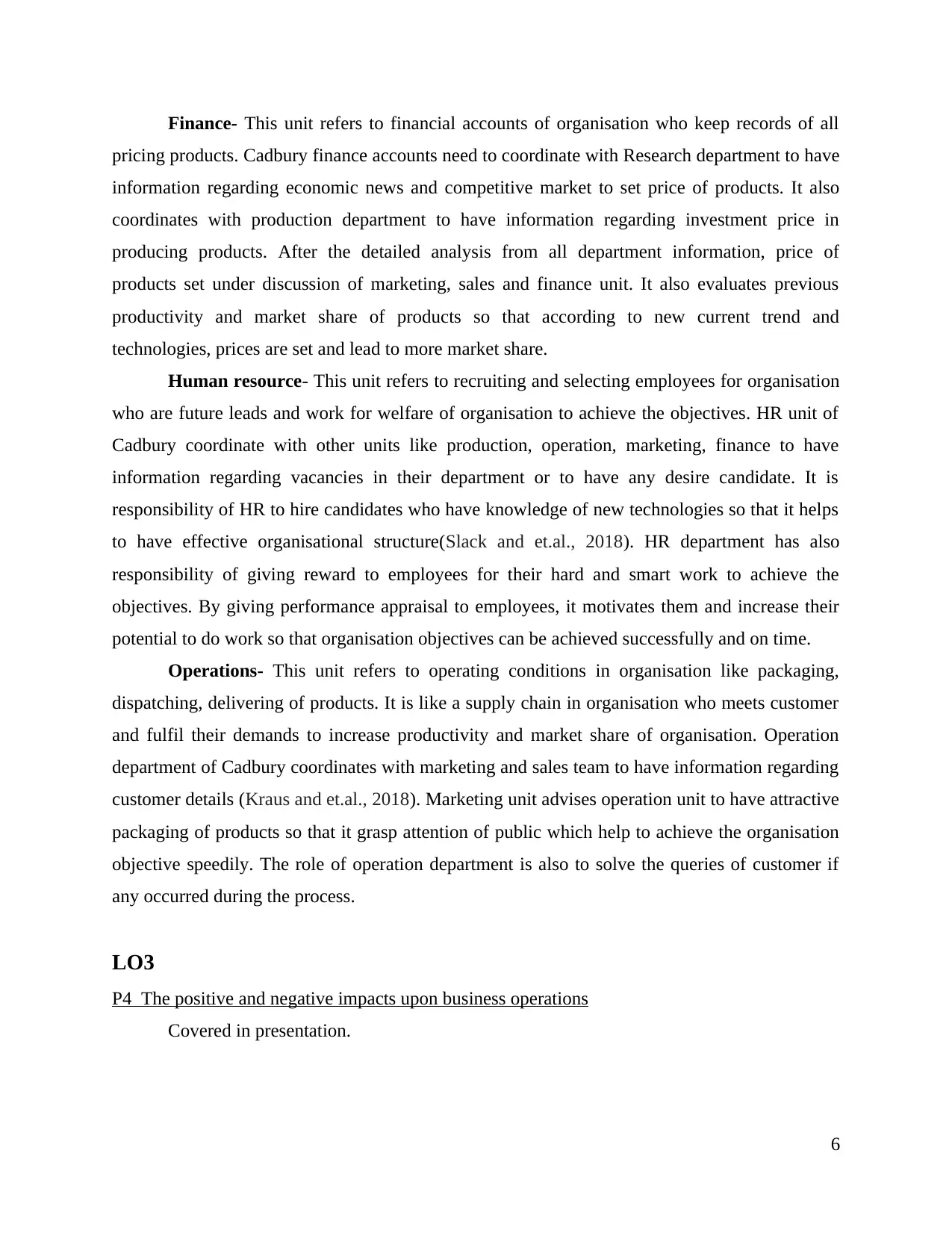
Finance- This unit refers to financial accounts of organisation who keep records of all
pricing products. Cadbury finance accounts need to coordinate with Research department to have
information regarding economic news and competitive market to set price of products. It also
coordinates with production department to have information regarding investment price in
producing products. After the detailed analysis from all department information, price of
products set under discussion of marketing, sales and finance unit. It also evaluates previous
productivity and market share of products so that according to new current trend and
technologies, prices are set and lead to more market share.
Human resource- This unit refers to recruiting and selecting employees for organisation
who are future leads and work for welfare of organisation to achieve the objectives. HR unit of
Cadbury coordinate with other units like production, operation, marketing, finance to have
information regarding vacancies in their department or to have any desire candidate. It is
responsibility of HR to hire candidates who have knowledge of new technologies so that it helps
to have effective organisational structure(Slack and et.al., 2018). HR department has also
responsibility of giving reward to employees for their hard and smart work to achieve the
objectives. By giving performance appraisal to employees, it motivates them and increase their
potential to do work so that organisation objectives can be achieved successfully and on time.
Operations- This unit refers to operating conditions in organisation like packaging,
dispatching, delivering of products. It is like a supply chain in organisation who meets customer
and fulfil their demands to increase productivity and market share of organisation. Operation
department of Cadbury coordinates with marketing and sales team to have information regarding
customer details (Kraus and et.al., 2018). Marketing unit advises operation unit to have attractive
packaging of products so that it grasp attention of public which help to achieve the organisation
objective speedily. The role of operation department is also to solve the queries of customer if
any occurred during the process.
LO3
P4 The positive and negative impacts upon business operations
Covered in presentation.
6
pricing products. Cadbury finance accounts need to coordinate with Research department to have
information regarding economic news and competitive market to set price of products. It also
coordinates with production department to have information regarding investment price in
producing products. After the detailed analysis from all department information, price of
products set under discussion of marketing, sales and finance unit. It also evaluates previous
productivity and market share of products so that according to new current trend and
technologies, prices are set and lead to more market share.
Human resource- This unit refers to recruiting and selecting employees for organisation
who are future leads and work for welfare of organisation to achieve the objectives. HR unit of
Cadbury coordinate with other units like production, operation, marketing, finance to have
information regarding vacancies in their department or to have any desire candidate. It is
responsibility of HR to hire candidates who have knowledge of new technologies so that it helps
to have effective organisational structure(Slack and et.al., 2018). HR department has also
responsibility of giving reward to employees for their hard and smart work to achieve the
objectives. By giving performance appraisal to employees, it motivates them and increase their
potential to do work so that organisation objectives can be achieved successfully and on time.
Operations- This unit refers to operating conditions in organisation like packaging,
dispatching, delivering of products. It is like a supply chain in organisation who meets customer
and fulfil their demands to increase productivity and market share of organisation. Operation
department of Cadbury coordinates with marketing and sales team to have information regarding
customer details (Kraus and et.al., 2018). Marketing unit advises operation unit to have attractive
packaging of products so that it grasp attention of public which help to achieve the organisation
objective speedily. The role of operation department is also to solve the queries of customer if
any occurred during the process.
LO3
P4 The positive and negative impacts upon business operations
Covered in presentation.
6
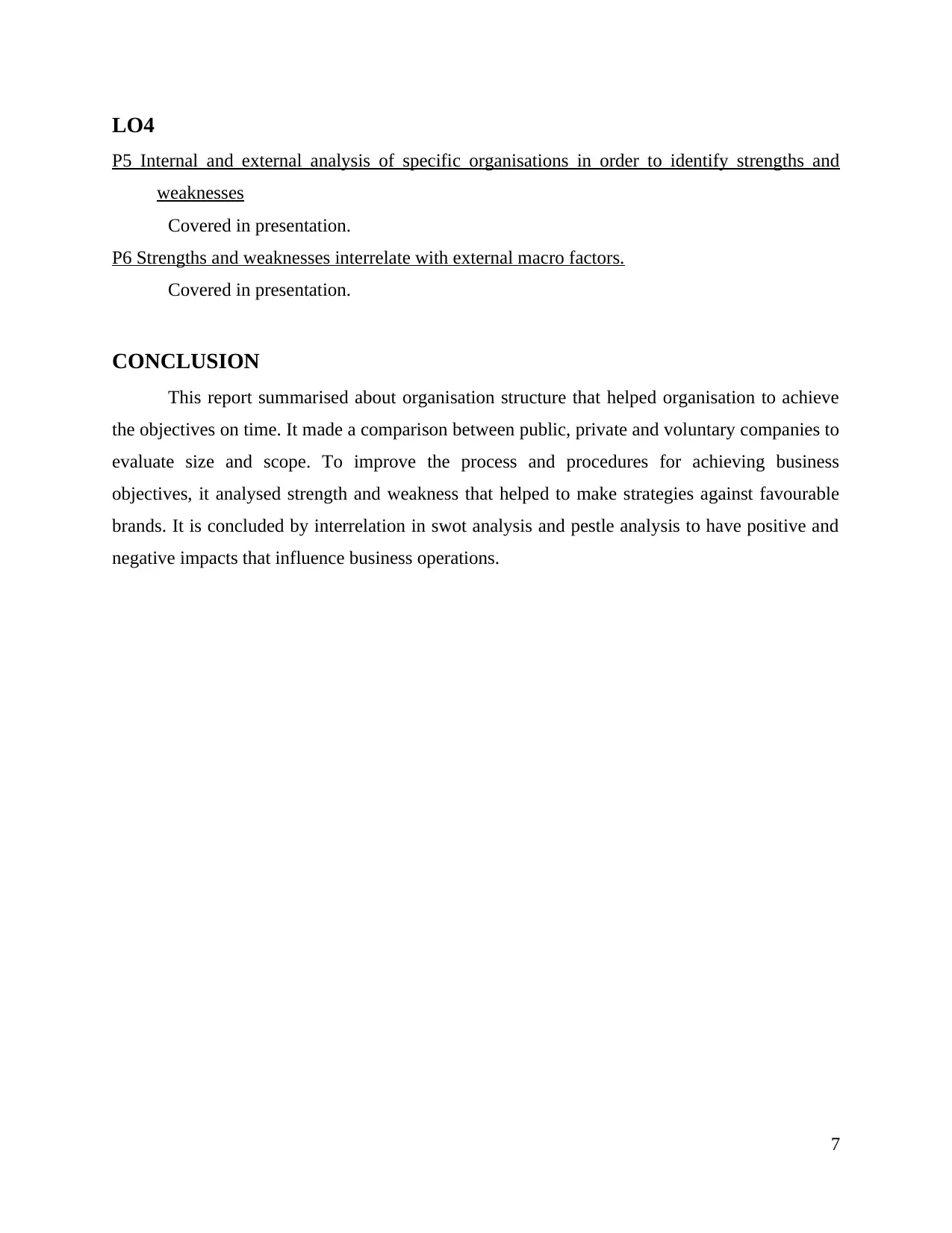
LO4
P5 Internal and external analysis of specific organisations in order to identify strengths and
weaknesses
Covered in presentation.
P6 Strengths and weaknesses interrelate with external macro factors.
Covered in presentation.
CONCLUSION
This report summarised about organisation structure that helped organisation to achieve
the objectives on time. It made a comparison between public, private and voluntary companies to
evaluate size and scope. To improve the process and procedures for achieving business
objectives, it analysed strength and weakness that helped to make strategies against favourable
brands. It is concluded by interrelation in swot analysis and pestle analysis to have positive and
negative impacts that influence business operations.
7
P5 Internal and external analysis of specific organisations in order to identify strengths and
weaknesses
Covered in presentation.
P6 Strengths and weaknesses interrelate with external macro factors.
Covered in presentation.
CONCLUSION
This report summarised about organisation structure that helped organisation to achieve
the objectives on time. It made a comparison between public, private and voluntary companies to
evaluate size and scope. To improve the process and procedures for achieving business
objectives, it analysed strength and weakness that helped to make strategies against favourable
brands. It is concluded by interrelation in swot analysis and pestle analysis to have positive and
negative impacts that influence business operations.
7
⊘ This is a preview!⊘
Do you want full access?
Subscribe today to unlock all pages.

Trusted by 1+ million students worldwide
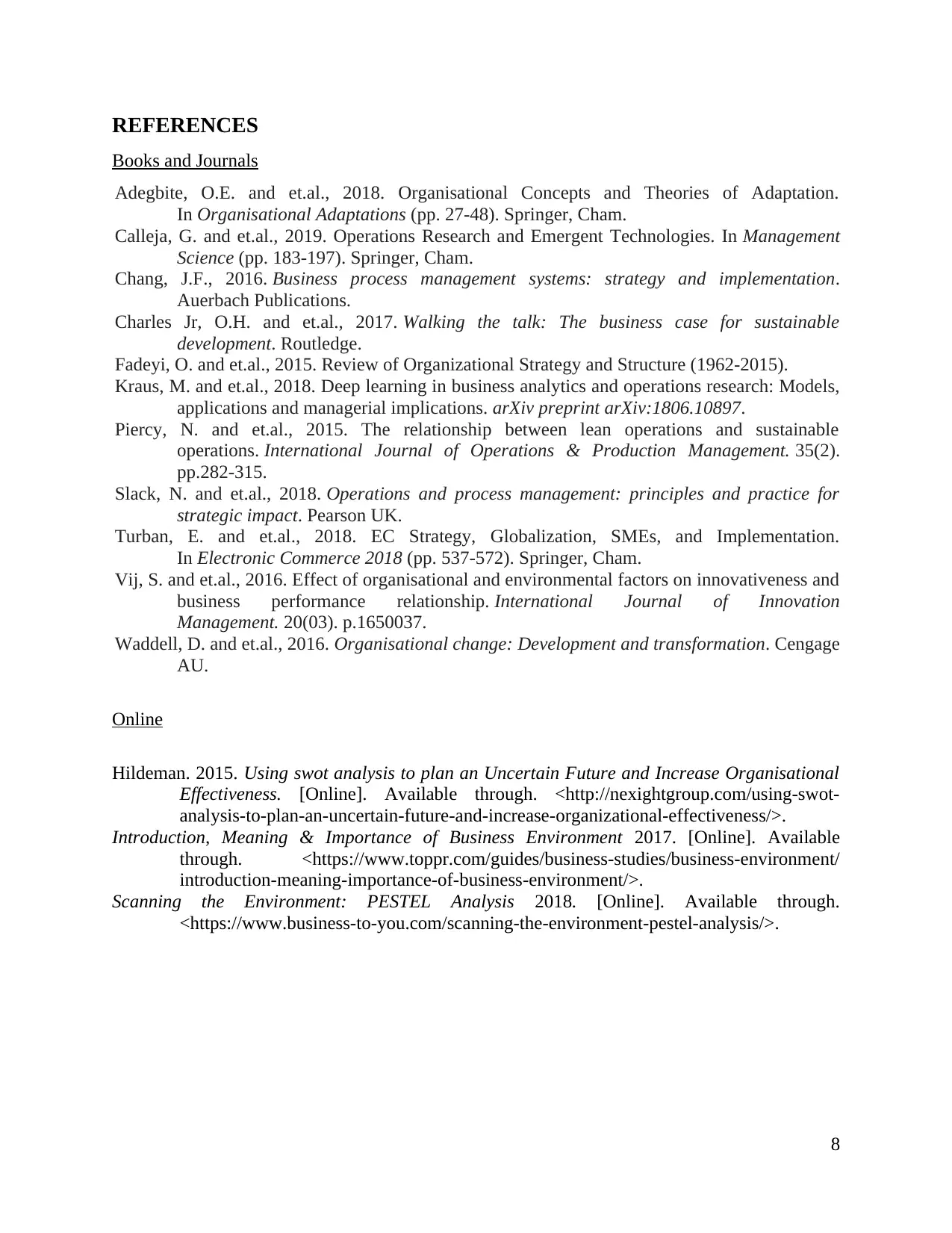
REFERENCES
Books and Journals
Adegbite, O.E. and et.al., 2018. Organisational Concepts and Theories of Adaptation.
In Organisational Adaptations (pp. 27-48). Springer, Cham.
Calleja, G. and et.al., 2019. Operations Research and Emergent Technologies. In Management
Science (pp. 183-197). Springer, Cham.
Chang, J.F., 2016. Business process management systems: strategy and implementation.
Auerbach Publications.
Charles Jr, O.H. and et.al., 2017. Walking the talk: The business case for sustainable
development. Routledge.
Fadeyi, O. and et.al., 2015. Review of Organizational Strategy and Structure (1962-2015).
Kraus, M. and et.al., 2018. Deep learning in business analytics and operations research: Models,
applications and managerial implications. arXiv preprint arXiv:1806.10897.
Piercy, N. and et.al., 2015. The relationship between lean operations and sustainable
operations. International Journal of Operations & Production Management. 35(2).
pp.282-315.
Slack, N. and et.al., 2018. Operations and process management: principles and practice for
strategic impact. Pearson UK.
Turban, E. and et.al., 2018. EC Strategy, Globalization, SMEs, and Implementation.
In Electronic Commerce 2018 (pp. 537-572). Springer, Cham.
Vij, S. and et.al., 2016. Effect of organisational and environmental factors on innovativeness and
business performance relationship. International Journal of Innovation
Management. 20(03). p.1650037.
Waddell, D. and et.al., 2016. Organisational change: Development and transformation. Cengage
AU.
Online
Hildeman. 2015. Using swot analysis to plan an Uncertain Future and Increase Organisational
Effectiveness. [Online]. Available through. <http://nexightgroup.com/using-swot-
analysis-to-plan-an-uncertain-future-and-increase-organizational-effectiveness/>.
Introduction, Meaning & Importance of Business Environment 2017. [Online]. Available
through. <https://www.toppr.com/guides/business-studies/business-environment/
introduction-meaning-importance-of-business-environment/>.
Scanning the Environment: PESTEL Analysis 2018. [Online]. Available through.
<https://www.business-to-you.com/scanning-the-environment-pestel-analysis/>.
8
Books and Journals
Adegbite, O.E. and et.al., 2018. Organisational Concepts and Theories of Adaptation.
In Organisational Adaptations (pp. 27-48). Springer, Cham.
Calleja, G. and et.al., 2019. Operations Research and Emergent Technologies. In Management
Science (pp. 183-197). Springer, Cham.
Chang, J.F., 2016. Business process management systems: strategy and implementation.
Auerbach Publications.
Charles Jr, O.H. and et.al., 2017. Walking the talk: The business case for sustainable
development. Routledge.
Fadeyi, O. and et.al., 2015. Review of Organizational Strategy and Structure (1962-2015).
Kraus, M. and et.al., 2018. Deep learning in business analytics and operations research: Models,
applications and managerial implications. arXiv preprint arXiv:1806.10897.
Piercy, N. and et.al., 2015. The relationship between lean operations and sustainable
operations. International Journal of Operations & Production Management. 35(2).
pp.282-315.
Slack, N. and et.al., 2018. Operations and process management: principles and practice for
strategic impact. Pearson UK.
Turban, E. and et.al., 2018. EC Strategy, Globalization, SMEs, and Implementation.
In Electronic Commerce 2018 (pp. 537-572). Springer, Cham.
Vij, S. and et.al., 2016. Effect of organisational and environmental factors on innovativeness and
business performance relationship. International Journal of Innovation
Management. 20(03). p.1650037.
Waddell, D. and et.al., 2016. Organisational change: Development and transformation. Cengage
AU.
Online
Hildeman. 2015. Using swot analysis to plan an Uncertain Future and Increase Organisational
Effectiveness. [Online]. Available through. <http://nexightgroup.com/using-swot-
analysis-to-plan-an-uncertain-future-and-increase-organizational-effectiveness/>.
Introduction, Meaning & Importance of Business Environment 2017. [Online]. Available
through. <https://www.toppr.com/guides/business-studies/business-environment/
introduction-meaning-importance-of-business-environment/>.
Scanning the Environment: PESTEL Analysis 2018. [Online]. Available through.
<https://www.business-to-you.com/scanning-the-environment-pestel-analysis/>.
8
1 out of 10
Related Documents
Your All-in-One AI-Powered Toolkit for Academic Success.
+13062052269
info@desklib.com
Available 24*7 on WhatsApp / Email
![[object Object]](/_next/static/media/star-bottom.7253800d.svg)
Unlock your academic potential
Copyright © 2020–2025 A2Z Services. All Rights Reserved. Developed and managed by ZUCOL.





